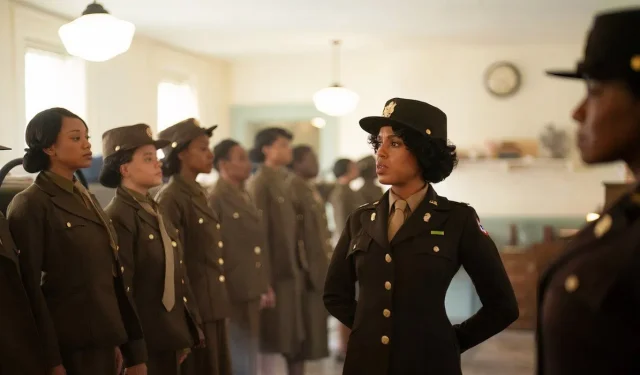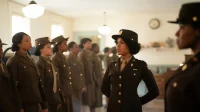Tyler Perry deserves recognition for his latest project, which dives deep into a lesser-known chapter of World War II. Unlike many war films that focus on grand battles and intense combat scenes, The Six Triple Eight sheds light on the historical significance of the U.S. Army’s 6888th Central Postal Directory Battalion, a story that has remained hidden for far too long. This film highlights the experiences of the only Women’s Army Corps unit of color deployed overseas in Europe during WWII, a testament to their struggles and resilience, despite its challenging narrative.
While the premise of The Six Triple Eight is compelling, it is not without its share of hurdles. The storytelling initially feels disjointed, commencing with a chaotic 1943 battle where soldiers face formidable enemies. A poignant moment arises when a soldier, grieving for a fallen comrade, retrieves a blood-soaked letter destined for a loved one and adds it to a mailbag. Although this letter is pivotal to the narrative, its significance is obscured by Perry’s choice to withhold key information until later in the film.
The narrative then shifts back to 1942, where we are briefly introduced to Lena (Ebony Obsidian) and Abram (Gregg Sulkin), an interracial couple facing societal disapproval as Abram prepares for war. Despite the challenges of their era, their bond deepens, leading them to promise to keep in touch through letters. Tragically, Lena learns of Abram’s death in battle, propelling her to enlist in the Women’s Army Corps with a resolve to “fight Hitler.”
Awkward Dialogue Hinders Performance
https://www.youtube.com/watch?v=7Thq-SBtukg
Up to this point, Perry sticks to his familiar pattern of using clunky dialogue to narrate events that have just unfolded. This approach often seems unnecessary, frustrating viewers and undermining the story’s integrity. The actors, compelled to deliver these awkward lines, suffer as a result, which detracts from their performances. The absence of skilled co-writers in the script is evident, a recurring issue in Perry’s productions.
After this rocky start, the film finally hits its stride when Lena arrives at basic training alongside diverse and colorful characters. Here, we meet Johnnie Mae (Shanice Shantay), who escapes an abusive relationship by enlisting; Delores (Sarah Jeffrey), a compassionate history enthusiast; Elaine (Pepi Sonuga), a math prodigy; and Bernice (Kylie Jefferson), who yearns for an education. This dynamic group forms a sisterhood marked by support, camaraderie, and a shared desire for more than what society expects of them. It’s in these interactions that Perry manages to positively portray Black women—an area where he has historically faltered.
The film could have benefitted from spending more time showcasing these women’s strengths and decision-making abilities. Despite enduring substantial racism and sexism, these trailblazing servicewomen committed themselves to the mission of uplifting both soldiers and their families. Under the capable leadership of Captain Charity Adams (played commendably by Kerry Washington), all 855 women seize the opportunity to demonstrate their worth by locating and delivering lost letters, addressing the significant communication void that plagued families during the war.
Storytelling Lacks Breathing Room
A crucial turning point occurs with the revelation of a special letter; however, the emotional impact of this moment is diluted by the film’s quick pacing. Perry’s tendency to introduce contrived elements adds to a broader issue in his filmmaking style—there is little room to absorb and reflect on critical events. The audience is often jolted from moments that could evoke genuine emotion, as Perry undermines his own narrative with abrupt shifts.
While history reveals an uplifting conclusion, the journey to that endpoint in The Six Triple Eight is often tedious and frustrating. The film appears to disproportionately fixate on the challenges these women faced rather than highlighting their invaluable contributions to the Army. Although issues of racism and sexism undoubtedly shaped their experiences, it is disappointing that a filmmaker like Perry, who has not always uplifted Black women in prior works, would create a film that misses the chance to honor their legacy fully. These women’s stories deserve a more respectful and nuanced representation.
The Six Triple Eight is currently available on Netflix, running for 127 minutes and rated PG-13 for language, thematic elements, and some scenes of wartime violence.


